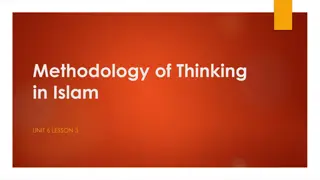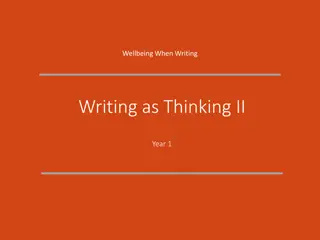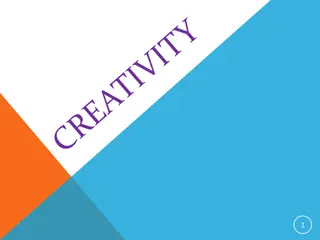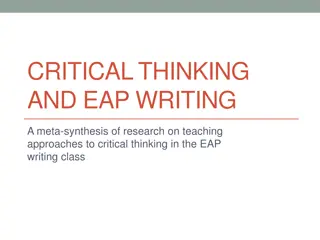Enhancing Strategic Thinking Skills through Exercises
This presentation deck focuses on the importance of developing foundational skills for effective strategic thinking, particularly for current and future army leaders. It covers key competencies such as continuous information gathering, learning, critical thinking, and understanding historical perspectives. The slides provide facilitators with context, exercises, and learning objectives to support participants in building and enhancing their strategic thinking abilities.
Download Presentation

Please find below an Image/Link to download the presentation.
The content on the website is provided AS IS for your information and personal use only. It may not be sold, licensed, or shared on other websites without obtaining consent from the author. Download presentation by click this link. If you encounter any issues during the download, it is possible that the publisher has removed the file from their server.
E N D
Presentation Transcript
Enhancing Strategic Thinking Skill Building Exercises Supporting slides 1
NOTE TO FACILITATORS The slides in this deck have been developed to provide the following to participants: 1) Context for the skill-building exercise including the importance of practicing foundational skills to become an effective strategic thinker 2) An overview of the exercise including the purpose, activities, and learning objectives 3) Brief tutorial facilitators may choose to adapt, add to, or re-arrange any portions of this slide deck to introduce the exercise to participants. Slides contained in the Background and Context portion of the slide deck (slides 3 10) appear in the slide decks for each of the four exercises. 2
CURRENT AND FUTURE ARMY LEADERS NEED TO BE ABLE TO THINK STRATEGICALLY Army leaders need to anticipate change, think long term, envision potential futures, and exploit opportunities to serve national interests Before Army leaders step into positions that require them to function as strategic thinkers and planners, they need to hone the building block skills that underpin strategic thinking Image credit: http://www.hawaiiarmyweekly.com/storage/2016/02/2378779-768x510.jpg 4
WHAT SKILLS ARE FOUNDATIONAL TO STRATEGIC THINKING ABILITY? Competency A Strategic Thinker continuously scans the environment seeks information from disparate sources suspends judgment and maintains an open mind considers other perspectives possesses advanced listening and research skills Comprehensive Information Gathering is a lifelong learner iteratively tests, reflects on, conceptualizes, and manages knowledge to gain insights on the environment continuously examines his/her own thinking Learning identifies the essential aspects of a situation questions assumptions and asks relevant questions seeks to identify meaningful connections and distinctions understands nuance considers the limits of data Critical Thinking 5
WHAT SKILLS ARE FOUNDATIONAL TO STRATEGIC THINKING ABILITY? (CONT D.) Competency A Strategic Thinker understands historical and contemporary contexts. recognizes patterns. forecasts possible futures. anticipates second-and third-order effects. has a long-term perspective. Thinking in Time generates creative and novel ideas, concepts, and approaches, independent of conventional norms. Innovative Thinking uses a holistic perspective of the dynamic and complex environment. identifies interrelationships and integrates disparate factors into a comprehensive whole. Systems Thinking 6
WHAT ELSE IS IMPORTANT TO STRATEGIC THINKING ABILITY? Competency A Strategic Thinker Has a solid foundation for strategic thinking based in: a broad general knowledge of many disciplines (e.g., geo-politics, world religions/cultures, economics, technology, sociology). knowledge specific to a strategic environment (e.g., local/regional customs, history, stakeholders). Knowledge Leverages the capabilities of others in a team or informal network (e.g., through cooperation, leadership, building trust, conflict management) to supplement his/her own strategic thinking. Collaboration Communicates candidly and effectively to gain individual understanding and move to the shared understanding required for strategy implementation. Is adept in the use of multiple media formats (oral, written, visual). Communicates well with diverse audiences that require tailored and persuasive messages. Communication Is intellectually humble. Accounts for his/her own natural limitations and biases related to emotion, perspective, and self-interest. Maintains respect for differing values and priorities. Emotional Regulation 7
STRATEGIC THINKING SKILL-BUILDING EXERCISES WILL HELP YOU BUILD SKILLS NEEDED FOR STRATEGIC THINKING. Exercises in this series include: Reflecting on Experience--provides practice in reflective thinking, learning from experience. Asking Powerful Questions--provides practice in questioning. Telling a Story--provides practice in systems thinking, synthesis. Envisioning Potential Futures -provides practice in thinking in time, strategic foresight. 8
THINK OF THESE EXERCISES AS COMPARABLE TO AN ATHLETIC DRILL. Professional basketball players don t just play a lot of basketball. They practice component skills ball handling, shooting baskets, rebounding, and footwork. Practicing these foundational skills repeatedly and over time is essential to becoming a skilled basketball player. Image credit: shutterstock.com 9
DEVELOPING STRATEGIC THINKING ABILITY ALSO REQUIRES TIME, PRACTICE, AND ATTENTION TO FOUNDATIONAL SKILLS. Doing any of the exercises once or twice will not transform you into a strategic thinker. They are analogous to the drills that athletes use to hone their skills. Developing advanced ST skills means repeatedly practicing the foundational skills necessary to become a great strategic thinker. The exercises can help you practice some of the (many) skills you ll need in order to become a skilled strategic thinker. Image credit: shutterstock.com 10
Overview Reflecting on Experience 11
WHATS THE PURPOSE OF THIS EXERCISE? Primary Purpose: To practice using reflection to promote continuous learning. Reflective Thinking The process of stepping back from a situation to think critically and deeply about the experience. Thinking critically before, during, and after an event provides an opportunity to develop greater understanding of both the self and the situation and inform future encounters with similar situations. Secondary Purpose: To help you recognize how to use reflection in daily operations to enhance learning and strategic thinking. Image credit: shutterstock.com 12
THE EXERCISE WILL ALSO HELP YOU PRACTICE THIS ADDITIONAL SKILL: Systems thinking Recognizing and describing relationships and interdependencies among factors that might otherwise appear unrelated. 13
WHAT WILL I DO IN THE EXERCISE? Identify a recent situation or event that did not go as you expected. Reflect on the event, using starter questions as an aid. Share your reflection with one or two other participants. Engage in a group discussion. 14
WHAT MATERIALS DO I NEED? Participant Guide (provided by facilitator) Pen/pencil Notebook/pad of paper Image credit: shutterstock.com 15
WHAT WILL I GAIN FROM THIS EXERCISE? Appreciate the importance of reflection for continuous learning Recognize the value of different types of questions for yielding unique types of information and deeper levels of learning. Demonstrate greater ease in reflecting on an experience Appreciate reflection as an opportunity to identify connections and inter- relationships that may not otherwise be apparent. Recognize when and how to use iterative reflection in daily operations 16
HOW DOES REFLECTIVE THINKING HELP US DEVELOP AS STRATEGIC THINKERS? Reflective thinking involves critically examining an experience to gain greater insight into the dynamics of a situation and our role in it. allows us to discover connections, inter-relationships, and underlying assumptions. helps us get smarter and transfer our learning to future events. can happen before, during, and after an event. Image credit: shutterstock.com 18
WHATS HARD? Multiple factors can inhibit reflection. Some people see reflective thinking as something that happens naturally, rather than a skill requiring deliberate practice. We tend to focus on what happened (content reflection), rather than thinking about how it occurred (process reflection) or why it occurred (premise reflection). o Only considering what can limit our learning 19
WHATS HARD? Multiple factors can inhibit reflection. (Cont d.) People tend to engage in reflection only after an event, rather than before and/or during an event. o This reduces the benefits of reflection Individuals often work alone when they reflect on events o Reflective thinking in a group setting can provide additional insights and valuable feedback. 20
WHATS HARD? Multiple factors can inhibit reflection. (Cont d.) Reflective practice requires making the time to engage in reflection; time is a limited resource Many leaders lack training in how to promote deep reflection or provide useful feedback on reflection. Image credit: shutterstock.com 21
TIPS FOR REFLECTIVE THINKING Ask yourself different types of questions (e.g., What? How? Why? Why not? What if? How might?) Engage in reflection iteratively before and during an event, as well as afterwards. Leverage different perspectives in your reflection activities. Record your reflections and share and discuss them with others. Work reflection into your everyday routine. Reflecting on both personal and work experiences will help build your reflective thinking skills. 22























